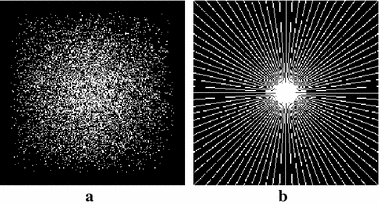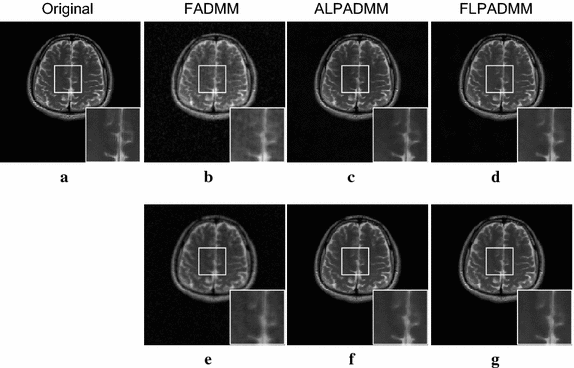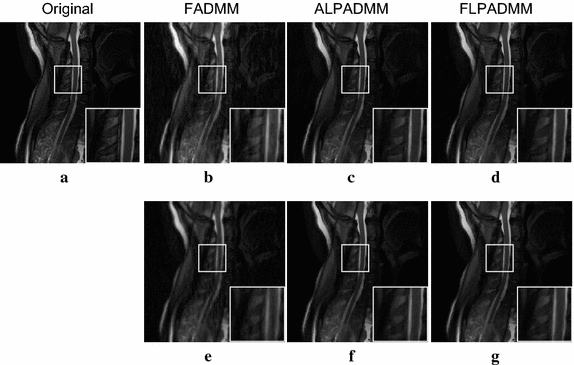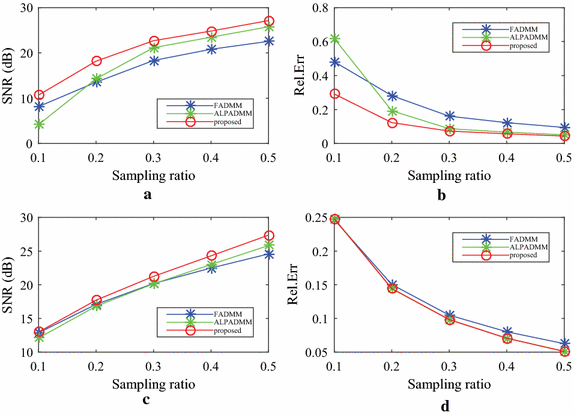Compressed sensing MRI via fast linearized preconditioned alternating direction method of multipliers
- PMID: 28449672
- PMCID: PMC5408387
- DOI: 10.1186/s12938-017-0343-x
Compressed sensing MRI via fast linearized preconditioned alternating direction method of multipliers
Abstract
Background: The challenge of reconstructing a sparse medical magnetic resonance image based on compressed sensing from undersampled k-space data has been investigated within recent years. As total variation (TV) performs well in preserving edge, one type of approach considers TV-regularization as a sparse structure to solve a convex optimization problem. Nevertheless, this convex optimization problem is both nonlinear and nonsmooth, and thus difficult to handle, especially for a large-scale problem. Therefore, it is essential to develop efficient algorithms to solve a very broad class of TV-regularized problems.
Methods: In this paper, we propose an efficient algorithm referred to as the fast linearized preconditioned alternating direction method of multipliers (FLPADMM), to solve an augmented TV-regularized model that adds a quadratic term to enforce image smoothness. Because of the separable structure of this model, FLPADMM decomposes the convex problem into two subproblems. Each subproblem can be alternatively minimized by augmented Lagrangian function. Furthermore, a linearized strategy and multistep weighted scheme can be easily combined for more effective image recovery.
Results: The method of the present study showed improved accuracy and efficiency, in comparison to other methods. Furthermore, the experiments conducted on in vivo data showed that our algorithm achieved a higher signal-to-noise ratio (SNR), lower relative error (Rel.Err), and better structural similarity (SSIM) index in comparison to other state-of-the-art algorithms.
Conclusions: Extensive experiments demonstrate that the proposed algorithm exhibits superior performance in accuracy and efficiency than conventional compressed sensing MRI algorithms.
Keywords: Alternating direction method of multipliers; Compressed sensing MRI; Image reconstruction; Total variation.
Figures










Similar articles
-
Smoothly clipped absolute deviation (SCAD) regularization for compressed sensing MRI using an augmented Lagrangian scheme.Magn Reson Imaging. 2013 Oct;31(8):1399-411. doi: 10.1016/j.mri.2013.05.010. Epub 2013 Jul 24. Magn Reson Imaging. 2013. PMID: 23891179
-
Local sparsity enhanced compressed sensing magnetic resonance imaging in uniform discrete curvelet domain.BMC Med Imaging. 2015 Aug 8;15:28. doi: 10.1186/s12880-015-0065-0. BMC Med Imaging. 2015. PMID: 26253135 Free PMC article.
-
Undersampled MRI reconstruction with patch-based directional wavelets.Magn Reson Imaging. 2012 Sep;30(7):964-77. doi: 10.1016/j.mri.2012.02.019. Epub 2012 Apr 13. Magn Reson Imaging. 2012. PMID: 22504040
-
An Algorithm Combining Analysis-based Blind Compressed Sensing and Nonlocal Low-rank Constraints for MRI Reconstruction.Curr Med Imaging Rev. 2019;15(3):281-291. doi: 10.2174/1573405614666180130151333. Curr Med Imaging Rev. 2019. PMID: 31989879 Review.
-
Physics-based reconstruction methods for magnetic resonance imaging.Philos Trans A Math Phys Eng Sci. 2021 Jun 28;379(2200):20200196. doi: 10.1098/rsta.2020.0196. Epub 2021 May 10. Philos Trans A Math Phys Eng Sci. 2021. PMID: 33966457 Free PMC article. Review.
Cited by
-
A consistency evaluation of signal-to-noise ratio in the quality assessment of human brain magnetic resonance images.BMC Med Imaging. 2018 May 16;18(1):17. doi: 10.1186/s12880-018-0256-6. BMC Med Imaging. 2018. PMID: 29769079 Free PMC article.
-
Accelerating cardiac diffusion tensor imaging combining local low-rank and 3D TV constraint.MAGMA. 2019 Aug;32(4):407-422. doi: 10.1007/s10334-019-00747-1. Epub 2019 Mar 22. MAGMA. 2019. PMID: 30903326
-
Compressed sensing magnetic resonance imaging (CS-MRI) diagnosis of rotator cuff tears.Am J Transl Res. 2024 Jan 15;16(1):147-154. doi: 10.62347/XRAF6615. eCollection 2024. Am J Transl Res. 2024. PMID: 38322573 Free PMC article.
References
-
- Donoho DL. Compressed sensing. IEEE Trans Inf Theory. 2006;52(4):1289–1306. doi: 10.1109/TIT.2006.871582. - DOI
-
- Lustig M, Donoho DL, Santos JM, Pauly JM. Compressed sensing MRI. IEEE Signal Process Mag. 2008;25(2):72–82. doi: 10.1109/MSP.2007.914728. - DOI
-
- Candès EJ, Wakin MB. An introduction to compressive sampling. IEEE Signal Process Mag. 2008;25(2):21–30. doi: 10.1109/MSP.2007.914731. - DOI
-
- Candès EJ, Romberg J, Tao T. Robust uncertainty principles: Exact signal reconstruction from highly incomplete frequency information. IEEE Trans Inf Theory. 2006;52(2):489–509. doi: 10.1109/TIT.2005.862083. - DOI
MeSH terms
LinkOut - more resources
Full Text Sources
Other Literature Sources
Medical
Research Materials

